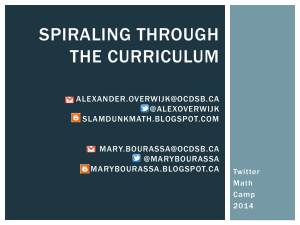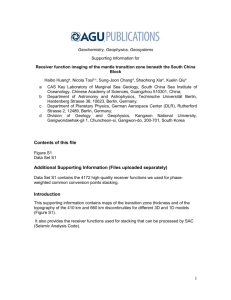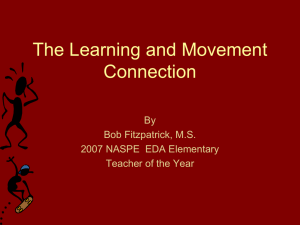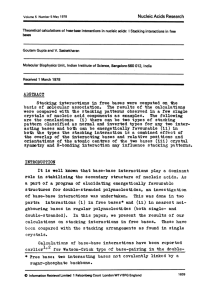This Is Your Brain On Exercise
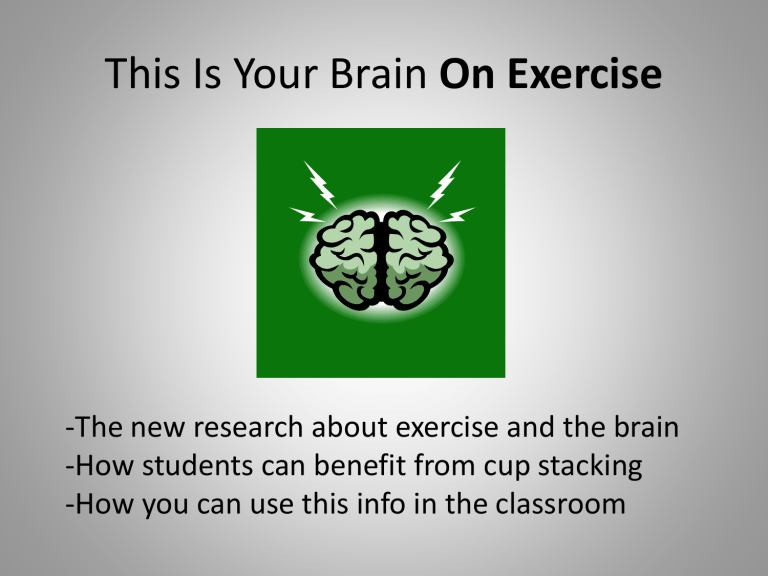
This Is Your Brain On Exercise
-The new research about exercise and the brain
-How students can benefit from cup stacking
-How you can use this info in the classroom
Common attitudes about health/exercise:
• Not a priority…we lack a true understanding of the mind-body connection and how exercise affects more than just our appearance…
• Exercise helps to “burn some energy”…actually exercise releases hormones that have a calming, focusing effect
• The myth of “Skinny = Healthy”
“I’m the same weight I was in high school”
• On eating unhealthy foods/eating in excess: “You’ve got room for it”
The truth is that our brain CRAVES exercise.
At a glance…how aerobic exercise and cup stacking benefits our students
• Physically: improves visual tracking, coordination/dexterity, hand speed, health and fitness
• Emotionally: enhances ability to cope with feelings of anger and stress, reduces behavioral issues, improves self-image, raises motivation through goal-setting, improves cooperative skills
• Cognitively: improves alertness and concentration, significantly enhances learning and recall of learned information
Case Studies and Testimonies
• Adam Leibovitz
http://www.bicycling.com/news/featured-stories/riding-my-ritalin?page=0,0
• Greg LeMond
– 3-time Tour de France winner (86, 89, 90)
– 1 st ever American and non-European to win TdF
– Experienced mild depression and ADHD symptoms
– Attributes cycling to helping him deal with his symptoms: “Exercise is not simply necessary; as
Dr. John Ratey clearly shows, it’s medicine.”
Case Studies:
School Districts That Focus on Fitness
• Titusville, PA
– Population of around 6,000
– 1 high school, 1 middle school, 4 elementary schools
– Median income is around $25,000
– Approximately 75% of kindergarteners on subsidized meal programs
– Overhauled their secondary schools, adding fitness centers, fitness diagnostic equipment, heart rate monitors to P.E. classes, and state of the art cardio equipment
– Since 2000 the middle school has not had one fist fight among an average of 550 students
– Standardized test scores have risen from below state averages to 17% above in reading and 18% in math
Case Studies:
School Districts That Focus on Fitness
• Woodland Elementary School – Kansas City, MO
– Nearly all students on subsidized meal programs
– In 2005, changed from physical education once a week to daily P.E. for 45 minutes
– Also shifted focus in P.E. towards cardiovascular activities
– Reported the number of incidents involving violence dropping from 228 to 95 in first year, and reduced total number of incidents requiring disciplinary action by 67%
The science behind it all…
from John Ratey’s book,
SPARK: The Revolutionary New Science of Exercise and the Brain
• Our brains are capable of growing new nerve cells (called
neurogenesis) and strengthening connections among each other our entire life. The more connections our nerve cells make among themselves, the stronger and faster our ability to learn and recall new information.
Paths → Roads → Highways → Freeways & Bypasses
• There are 2 ways to grow and strengthen these connections:
-Aerobic exercise
-Complex tasks that require bilateral coordination and/or that cross the midline (cross-lateralization) i.e. Playing a musical instrument or CUP STACKING!
• These different types of tasks compliment one another
Brain-derived neurotrophic factor (BDNF)
• “Miracle Gro” for new nerve cells in the brain
• A hormone that pools near the synapses where signals
(information) are transmitted between nerve cells in the brain
• BDNF helps grow and protect nerve cells
• When we exercise, most of our blood is sent to working muscles to deliver glycogen and oxygen but…
• Almost immediately after aerobic exercise, blood and BDNF flood the pre-frontal cortex of the brain, the part of our brain that is responsible for creativity and “cognitive flexibility”…the ability to learn new info.
Thoughts about Exercise and the Brain:
• The effect of aerobic exercise is like a little bit of Ritalin and a little bit of Prozac.
• Improves learning on 3 levels
1. Optimizes alertness, attention, and motivation
2. Prepares/encourages nerve cells to connect to one another, the basis for learning new info
3. Spurs development of new nerve cells in the brain
• Slows the natural nerve cell deterioration associated with aging, possible preventive of Alzheimer’s
• The area of the brain affected the most after exercise (prefrontal cortex) controls executive function, or decision making, allowing the individual to think about a decision before acting on it. This is a function that students with
ADHD symptoms have a very difficult time controlling.
Complex Tasks
• Activities that require us to coordinate movements involving both sides of our body force us to create new connections between nerve cells in the brain
• BRAIN EXERCISES
– Double Doodle – words, pictures
– Rock, Paper, Scissors
– Countdown
– Hand Weave
– Gotcha!
– Fingers, Toes, and Friends
– Copy Cat (follow your partner’s/teacher’s pattern)
– Keyboard (with/without music)
– Body Writing
Cup Stacking
This complex task involves:
• CROSS-LATERALIZATION (also known as crossing the midline)
• BILATERAL COORDINATION (coordinating both sides of the body)
*These require activating both hemispheres of the brain
• Using both hands in alternating fashion, specific patterns are created with the cups, usually completed as quickly as possible.
Cup Stacking Activities
• Rapid Fire, Tower Stack Shuttle/Sit-ups, Stack 12
• Competition Stacks (AKA Sport Stacking) – 3-3-3, 3-6-3, Cycle
– Partners, take turns “coaching”
• Leader of the Stack
• Stack Deck
– Races
– “Seeing Eye Dog”
• Shuffle Stacking
• Partner Stacking
• BattleStack http://www.speedstacks.com
“Stackademics”
• Tailored for use in the classroom
• Integrates cup stacking with core subjects
• Could be used for incentives, stations/centers, checkout for home use, class competitions, etc.
• Get Stackademics or a Sport Pack for your grade level to share
• Mini-grants
• Group Orders
• World STACK UP! Day – November 17 th http://www.stackademics.com/
Speed Stacks Quick Links
• “How to” video clips http://www.speedstacks.com/about/how_to_stack.php
• Cup stacking videos http://www.speedstacks.com/videos/
• All about cup stacking http://www.speedstacks.com/about/history.php
• The benefits and research behind cup stacking http://www.speedstacks.com/parents/benefits.php
• Speed Stacks store http://www.speedstacks.com/store/teacher/
How you can use this info in your classroom…
• Teach new and/or complex concepts after students return from recess or P.E. class, or take a short exercise break outside beforehand
• “Brain Exercises” or “Brain Energizers” – make them a part of your schedule so students can count on them
• Use a timer to stay on track with your “Brain Breaks”
• Have a checklist of break activities ranging from 5-20 minutes in length…pick a student to choose one of the tasks on the checklist
• Let students draw “Brain Break” activities from a hat
• Implement STACKADEMICS

